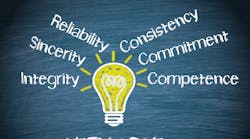When products are commoditized, manufacturers must compete on services, business models and intangible dimensions of their value proposition. In many cases, intangibles are tie breakers when customers make choices among vendors and award contracts.
That can no longer be the case. Today, intangible differentiators must be an integral part of value propositions.
“Intangibles” typically refers to elements of an offering that are not physical in nature. They are part of the overall value propositions but cannot be physically touched by customers. They include elements around products and services, such as longevity, experience, reputation, flexibility, trust, relationship and many more.
There is still confusion in the industrial world. Some consider services by nature intangible. I disagree. Over the past ten years, services have received greater attention, and investments in “servitization” have led to a greater level of formalization. The tangibility of services is materialized in the form of service teams, service technicians, service contracts, reports, software, etc. Therefore, services are highly tangible.
Formalizing intangible offers is not an easy task. It requires multi-functional attention and intelligence. How do you get started? I propose five steps to implement and repeat depending on your company size and divisional scope. Here they are:
1. Identify the list of your critical intangible differentiators: gather a multi-functional team and go through a brainstorming session. List all potential intangible differentiators after you remove all duplicate answers. You should end up with a shortlist of a dozen intangible elements.
2. Prioritize those differentiators: Rate your differentiators using the VRIO framework: V = does this bring economic value to customers; R = is it rare to find in the market”; I = can you be imitated in the market?; O=are you organized to exploit the intangible differentiator? Use a 1 to 10 scale and calculate a total score out of 40 points. Select the top 3 to 5 by considering the highest score, the highest score on the V, then a highest score on the I. You need to focus on the intangibles that bring the highest economic value to customers. For example, if you have the greatest level of operational flexibility, you might save customer money by reducing the operation risk of shutting down their line if they did not plan properly.
3. “Productize” them by translating them into formal activities and programs: This is the most important step of the process. Intangibles have to be translated into concrete programs and activities. They cannot stay in the form of actions, ideas or intentions. For example, if you offer great operational flexibility, you need to list the specific activities that are included into the program: change-order time, capacity allocation, volume allocation for the next budget cycle, ability to adjust production planning, stock availability, minimum order quantities, etc.
4. Estimate the economic value of each of the programs and activities: This is the value-modeling exercise during which we turn intangible differentiators into customer benefits, and then into value drivers. We then quantify the financial impact of the program and/or activity for the customers. This step requires deep knowledge of the customer process and profit-and-loss statement. If, for example, production flexibility is a key differentiator, it means we are able to avoid the risk of shutting down customer plants or we can the customer money by not having to expedite shipments or hold high quantities of stock. That is translated into dollar savings per order, per production run, or per shipment. You repeat this exercise for each intangible program or activity.
5. Produce relevant value documents: The final step is to capture the richness of these exercises and to design formal customer-value-proposition documents, value selling sheets, battle cards, value case studies, etc. These value assets are used to train the sales team on the “intangible” products so that they can use them to justify price premiums and resist the need to offer discounts.
Industrial companies can no longer ignore the importance of intangible dimensions of their customer value proposition. Intangible value drivers cannot be an afterthought in their responses to customer RFPs and in long-term contracts. As companies invest more and more in digital transformation and sustainability, the sense of urgency to capture this value is high.
By making the intangible concrete and tangible, industrial companies are better positioned to compete and extract value from the markets. It is no longer an option. It is a must-do.
Stephan Liozu is founder of Value Innoruption Advisors, a consulting boutique specializing in industrial pricing, XaaS pricing and value-based pricing. He is also the co-founder of Pricing for the Planet, which specializes in pricing for sustainability. Stephan has 30 years of experience in the industrial sector with companies like Owens Corning, Saint-Gobain, Freudenberg and Thales.



